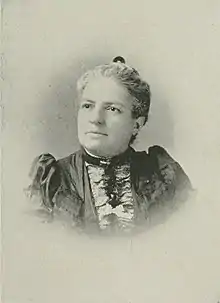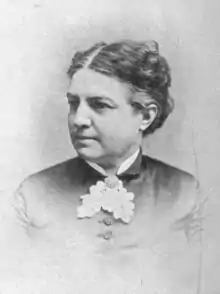Esther T. Housh | |
|---|---|
 | |
| Born | Esther Caroline Taylor October 27, 1840 Ross County, Ohio, U.S. |
| Died | May 7, 1898 (aged 57) Boston, Massachusetts, U.S. |
| Resting place | Lindenwood Cemetery, Fort Wayne, Indiana, U.S. |
| Occupation | Editor, Author, Social Activist |
| Nationality | American |
| Spouse | Frank Housh |
| Children | 2 |
| Signature | |
Esther T. Housh (née, Taylor; October 27, 1840 – May 7, 1898) was a 19th-century American social reformer, author, and newspaper editor. While serving as national press superintendent of the Woman's Christian Temperance Union (WCTU), she instituted the National Bulletin. She was the editor of The Woman's Magazine,[1] as well as the author of many temperance leaflets,[2] and poems.[3] Housh died in 1898.
Early years and education
Esther Caroline Taylor was born in Ross County, Ohio, October 27, 1840.[4] She was descended from Scotch and English ancestors. Her grandfather was Col. Robert Stewart, of Ohio, whose home was a station on the Underground Railroad. Her grandmother was the first one of the family to sign the Washingtonian pledge. Her father was a Congregational church minister. Her parents were Isaac Newton Taylor and Margaretta Stewart Taylor. Housh was the second child in a family of eight, and her early days were full of responsibilities.[3] Among her siblings were two brothers, Charles N. Taylor and Robert S. Taylor.[5]
In childhood, she became a believer in woman's rights. She received a liberal education, studying Greek and Latin while busy with the work associated with home.[3]
Career

At an early age, she married Frank Housh at her grandfather's home, near Champaign, Illinois.[6] He was the publisher of The Woman's Magazine, and she was the editor.[7] They had two children, one of whom died in childhood.[3] The Woman's Century commenced publication in Louisville, Kentucky in 1877, and was continued by Housh in Brattleboro, Vermont, until 1890.[3]
Housh became prominent in the temperance movement. In 1883, she was sent from Brattleboro as a delegate to the Vermont state convention in Randolph, Vermont. She was invited to attend the national convention in Detroit, Michigan, and there, she was elected national press superintendent of the Woman's Christian Temperance Union (WCTU). She held that position until 1888. She instituted the National Bulletin, which averaged 80,000 copies a year. She wrote special reports and numerous leaflets, some of which reached a sale of 200,000 copies. In the national conventions in Nashville, Tennessee and New York City, she furnished a report to a thousand selected papers. In 1885, she was elected State secretary of the Vermont WCTU, and thereafter had editorial charge of Our Home Guards, the State organ. In 1877, she was elected State president of Vermont.[3]
In 1890 and 1891, in Boston, Massachusetts, she edited the Household, which had been removed from Brattleboro. In 1891, she returned to Brattleboro.[3] In 1892, she removed again to Boston to assist on the Household, and subsequently became editor of Our message, the organ of the Massachusetts WCTU.[2] In 1894, she was elected corresponding secretary of the Massachusetts WCTU. She also did literary work while in Boston.[8]
Death
Housh died in Boston, May 7, 1898.[4] Interment was at Lindenwood Cemetery, Fort Wayne, Indiana.[9]
References
- ↑ Smith 1888, p. 628.
- 1 2 "Funeral of Mrs Housh, she was prominent in temperance work for many years". Newspapers.com (Public domain ed.). The Boston Globe. 10 May 1898. p. 8. Retrieved 10 March 2019.

- 1 2 3 4 5 6 7 Willard & Livermore 1893, p. 394.
- 1 2 Cherrington 1926, p. 1253.
- ↑ Herringshaw 1904, p. 5.
- ↑ Moulton 1892, p. 264.
- ↑ Demorest 1885, p. 456.
- ↑ "Mrs. Esther T. Housh". Newspapers.com (Public domain ed.). Wilkes-Barre Times Leader, The Evening News. 7 December 1894. p. 7. Retrieved 10 March 2019.

- ↑ "Mrs. Esther T. Housh, death in Boston of a former president of the Vermont W. C. T. U." Newspapers.com (Public domain ed.). Brattleboro Evening Phoenix. 10 May 1898. p. 1. Retrieved 10 March 2019.

Attribution
 This article incorporates text from this source, which is in the public domain: Demorest, W.J. (1885). Demorest's Family Magazine. Vol. 21 (Public domain ed.). W.J. Demorest.
This article incorporates text from this source, which is in the public domain: Demorest, W.J. (1885). Demorest's Family Magazine. Vol. 21 (Public domain ed.). W.J. Demorest. This article incorporates text from this source, which is in the public domain: Herringshaw, Thomas William (1904). Herringshaw's Encyclopedia of American Biography of the Nineteenth Century: Accurate and Succinct Biographies of Famous Men and Women in All Walks of Life who are Or Have Been the Acknowledged Leaders of Life and Thought of the United States Since Its Formation ... (Public domain ed.). American Publishers' Association.
This article incorporates text from this source, which is in the public domain: Herringshaw, Thomas William (1904). Herringshaw's Encyclopedia of American Biography of the Nineteenth Century: Accurate and Succinct Biographies of Famous Men and Women in All Walks of Life who are Or Have Been the Acknowledged Leaders of Life and Thought of the United States Since Its Formation ... (Public domain ed.). American Publishers' Association. This article incorporates text from this source, which is in the public domain: Moulton, Charles Wells (1892). The Magazine of Poetry and Literary Review. Vol. 4 (Public domain ed.). Charles Wells Moulton.
This article incorporates text from this source, which is in the public domain: Moulton, Charles Wells (1892). The Magazine of Poetry and Literary Review. Vol. 4 (Public domain ed.). Charles Wells Moulton. This article incorporates text from this source, which is in the public domain: Smith, Eva Munson (1888). Woman in Sacred Song: A Library of Hymns, Religious Poems and Sacred Music by Woman : Containing Selections from the Writing of More Than Seven Hundred Authors ... Also Short Biographical Sketches of Many of the Writers (Public domain ed.). Standard Pub.
This article incorporates text from this source, which is in the public domain: Smith, Eva Munson (1888). Woman in Sacred Song: A Library of Hymns, Religious Poems and Sacred Music by Woman : Containing Selections from the Writing of More Than Seven Hundred Authors ... Also Short Biographical Sketches of Many of the Writers (Public domain ed.). Standard Pub. This article incorporates text from this source, which is in the public domain: Willard, Frances Elizabeth; Livermore, Mary Ashton Rice (1893). "Esther Housh". A Woman of the Century: Fourteen Hundred-seventy Biographical Sketches Accompanied by Portraits of Leading American Women in All Walks of Life (Public domain ed.). Moulton.
This article incorporates text from this source, which is in the public domain: Willard, Frances Elizabeth; Livermore, Mary Ashton Rice (1893). "Esther Housh". A Woman of the Century: Fourteen Hundred-seventy Biographical Sketches Accompanied by Portraits of Leading American Women in All Walks of Life (Public domain ed.). Moulton.
Bibliography
- Cherrington, Ernest Hurst (1926). Standard Encyclopedia of the Alcohol Problem. American Issue Publishing Company.